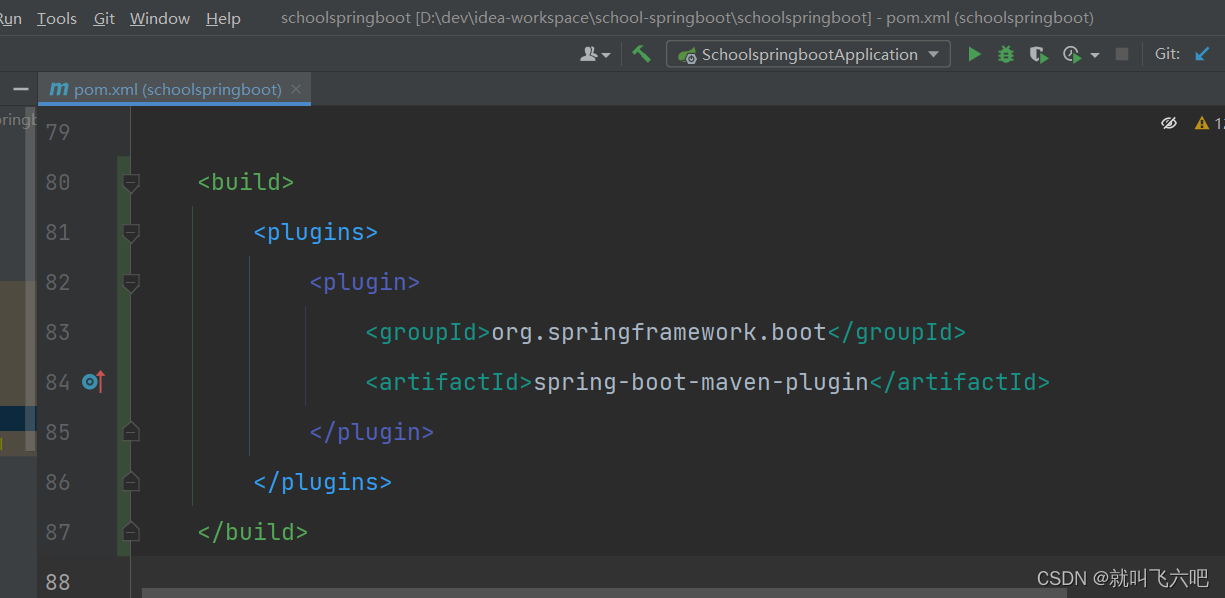简单点,再简单点,alt+q 隐藏、显示桌面图标!
!q::
HideOrShowDesktopIcons()
returnHideOrShowDesktopIcons()
{ControlGet, class, Hwnd,, SysListView321, ahk_class ProgmanIf class =ControlGet, class, Hwnd,, SysListView321, ahk_class WorkerWIf DllCall("IsWindowVisible", UInt,class)WinHide, ahk_id %class%ElseWinShow, ahk_id %class%
};双击桌面右上角显示隐藏桌面图标#Persistent
CoordMode, Pixel, Screen
CoordMode, Mouse, Screen
;~ 桌面Progman|WorkerW
GroupAdd, Desktop, ahk_class ExploreWClass
GroupAdd, Desktop, ahk_class WorkerW
WaitTime := DllCall("GetDoubleClickTime")/1000
;屏幕左上
x1:=0
y1:=0
;任务栏高度
WinGetPos,,,, h,ahk_class Shell_TrayWnd
;屏幕右下
x2:=A_ScreenWidth
y2:=A_ScreenHeight-h
OutputDebug %x2%,%y2%
#IfWinActive, ahk_group Desktop
~LButton::
KeyWait,LButton
KeyWait, LButton, d T %WaitTime%+200
If ! Errorlevel
{MouseGetPos,x,yOutputDebug %x%-%y%;~ if (x<x1+10 and y<y1+10 ) ;屏幕左上角10*10见方。;~ { ;~ OutputDebug 左上角;~ HideOrShowDesktopIcons();~ }if (x>x2-10 and y<y1+10 ) ;屏幕右上角10*10见方。{ OutputDebug 右上角HideOrShowDesktopIcons()}else if (x<x1+10){OutputDebug 左边;~ Run notepad}else if (y<y1+10){OutputDebug 上边;~ Run notepad}else if(x>x2-10){OutputDebug 右边;~ run calc}else if(y>y2-10){OutputDebug 下边;~ run calc}else{OutputDebug 其它ToolTip %x%-%y%Sleep,1000ToolTip}
}
returnHideOrShowDesktopIcons()
{ControlGet, class, Hwnd,, SysListView321, ahk_class ProgmanIf class =ControlGet, class, Hwnd,, SysListView321, ahk_class WorkerWIf DllCall("IsWindowVisible", UInt,class)WinHide, ahk_id %class%ElseWinShow, ahk_id %class%
}以下可以不看了。
How to Hide All Desktop Icons in Windows 10
Your Desktop is a special folder which shows your background wallpaper that you have chosen and your files, folders, documents, shortcuts and all such items you have stored. It appears every time you sign in to Windows. Today, we will see how to quickly hide your desktop contents.
RECOMMENDED: Click here to fix Windows errors and optimize system performance
Tip: In earlier Windows versions, the Desktop had important icons enabled by default - This PC, Network, Control Panel, and your User files folder. They were all visible by default. However, in modern Windows versions, Microsoft made most of these icons hidden. In Windows 10, only the Recycle Bin is present on the Desktop by default. Also, the Windows 10 Start Menu does not have links to these icons either. You can enable classic Desktop icons as follows:
Enable Desktop Icons in Windows 10
To hide all desktop icons in Windows 10, you can do the following.
- Minimize all open windows and apps. You can use Win + D or Win + M shortcut keys. Alternatively, you can right-click the taskbar and select "Show the desktop" from the context menu or left click the far end of the taskbar.
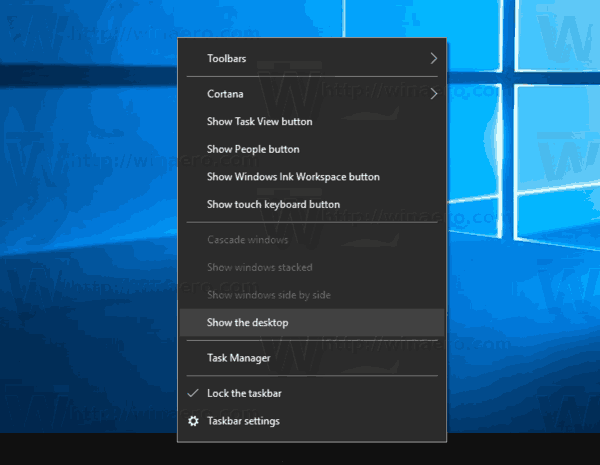 Tip: See What is the difference between Win + D (Show Desktop) and Win + M (Minimize All) keyboard shortcuts in Windows
Tip: See What is the difference between Win + D (Show Desktop) and Win + M (Minimize All) keyboard shortcuts in Windows - Right click the empty space on your Desktop and select View - Show Desktop Icons. This command will toggle the visibility of your Desktop icons.
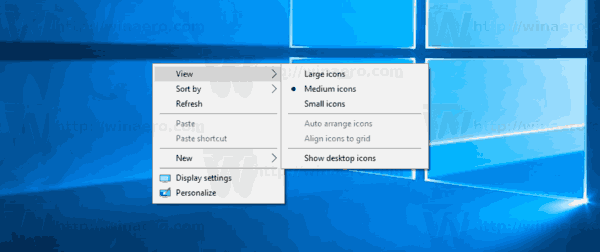
This is pretty simple.
Depending on your production environment, it may be necessary to disable Desktop icons for all users in your Active Directory/domain, a specific user on your computer or for all users of your PC. In this case, you can use a special Group Policy item or a Registry tweak. Let's review them.
If you are running Windows 10 Pro, Enterprise, or Education edition, you can use the Local Group Policy Editor app.
Hide All Desktop Icons in Windows 10 with Group Policy
- Press Win + R keys together on your keyboard and type:
gpedit.mscPress Enter.
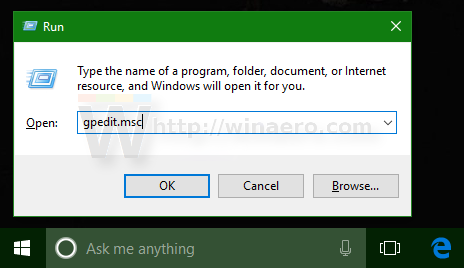
- Group Policy Editor will open. Go to User Configuration\Administrative Templates\Desktop. Enable the policy option Hide and disable all items on the desktop as shown below.
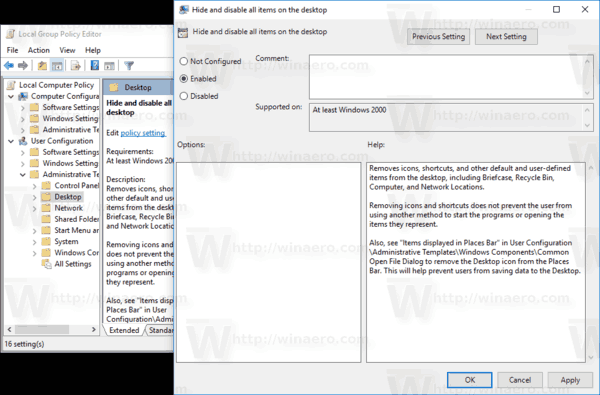
Hide All Desktop Icons in Windows 10 with a Registry tweak
- Open Registry Editor.
- Go to the following Registry key:
HKEY_CURRENT_USER\Software\Microsoft\Windows\CurrentVersion\Policies\ExplorerTip: See how to jump to the desired Registry key with one click.
If you do not have such a key, then just create it.
- Here, create a new 32-bit DWORD value NoDesktop. Note: Even if you are running 64-bit Windows, you still need to use a 32-bit DWORD as the value type.
Set it to 1 to hide desktop icons.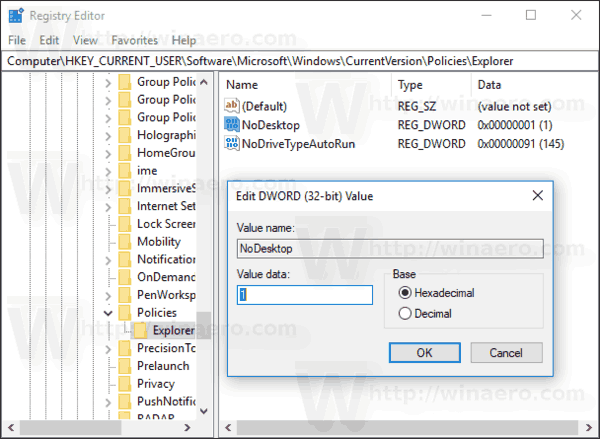
- To make the changes done by the Registry tweak take effect, you need to sign out and sign in again to your user account.
Later, you can delete the NoDesktop value to allow the user to use Desktop icons.
To apply this option for all users, ensure that you are signed in as Administrator before proceeding.
Then, go to the following Registry key:
HKEY_LOCAL_MACHINE\Software\Microsoft\Windows\CurrentVersion\Policies\ExplorerCreate the same value here, NoDesktop as described above.

